Neil Clarke's Blog, page 26
April 2, 2016
Clarkesworld Magazine – April 2016

Our April 2016 issue (#115) contains:
Original fiction by Carolyn Ives Gilman (“Touring with the Alien”), Gregory Feeley (“The Bridge of Dreams”), Sara Saab (“The Cedar Grid”), and Chen Qiufan (“Balin”).
Reprints from Garth Nix (“Old Friends”) and Elizabeth Hand (“Winters Wife”).
Non-fiction by Jason Heller (Silver Machine: Hawkwinds Space Rock Journey throughout Science Fiction and Fantasy), an interview with David Brin, an Another Word column by Margot Atwell, and an editorial by Neil Clarke.
PURCHASE THIS ISSUE AT:
Amazon Kindle
B&N EPUB
Clarkesworld Android App – Google Play
Clarkesworld iPad/iPhone App – iTunes
Kobo EPUB
Weightless EPUB/MOBI
Wyrm EPUB/MOBI
March 23, 2016
Brooklyn Speculative Fiction Writers
In the last month, I’ve been in Boston, Houston, Orlando, and Brooklyn. Last night, the Brooklyn Speculative Fiction Writers group had me speak as part of their Expert Meetup series. The topic was one I’ve talked about (formally and informally) at all of those stops: the state of the short fiction field. In last night’s talk, I made reference to several data posts and editorials I’ve written in the last year or so. Rather than make people track them all down, I thought it might be a good idea to use this post as an index.
The 2015 Clarkesworld submissions stats I mentioned can be found here.
In April 2015, I did an analysis of the short story titles in our submissions system. This post has some comments and links to the word frequency Wordle and the most frequently used titles post.
In 2015, I ran a open survey for authors to test a theory about my story selection process. It asked authors to provide some basic demographics and the names of up to five authors that were their biggest influences. The survey results and my theory can be found here. I also included demographic information here.
Last September, I published my first Sad Truth editorial. I didn’t mention it last night, but it has bearing on the field as a whole. This one talked about short fiction reviews and how the current system fails us. Details here.
That editorial was followed by the Sad Truth about Short Fiction Magazines. This is the one that is being talked about at Eastercon this weekend and triggered more than a couple of knee-jerk responses over the whole hobby/IRS thing. The piece was inspired by some thoughts I was gathering for my introduction to The Best Science Fiction of the Year. Read here.
A side comment “Maybe we should be talking about how we can make short fiction magazines thrive rather than simply survive.” was on Facebook here and generated a lot of discussion. I plan on expanding on this at some point using some of the things I mentioned last night.
If I forgot something (or you’d like some further detail or different data slice), please leave a comment or email and I’ll add it.
March 21, 2016
I appear to have inspired a panel
A friend suggested I take a look at the program for Mancunicon (2016 Eastercon) and it appears as though I’m responsible for a panel:
Supporting the Short Stuff
Room 7, 1pm – 2pm
Val Nolan, Ruth EJ Booth, Matthew Hughes, Juliet Kemp, E.G. Cosh
In his editorial for the November 2015 issue of Clarkesworld, Neil Clarke warned that the current boom in SF short fiction may be coming to an end: new markets are appearing continuously, but very few have truly viable business models in the sense of being able to sustain themselves and pay their editors and contributors. At the same time, the growth in markets has been a key factor in the increasing diversity of SF short fiction. So is the current landscape healthy or not? Is it realistic to aspire to full sustainability for today’s magazines, or is limited crowdfunding enough (or even advantageous)? Is a crash coming, and if it is what should we do about it?
It’s a bit of a dramatic interpretation of my editorial, but hey, if it gets people talking about building a sustainable future for short fiction then I’m good with that. As I see it, we have two paths (more likely a combination of the two):
The number of magazines self-corrects downward making the marketplace more sustainable
We market better and bring more people into the community, giving the field a bit of a boost
I’ll add some counter-questions to their list:
Is it realistic to expect people to continue publishing when they lose money or go unpaid? Most people seem to agree that authors should be paid? Why is it such a stretch to think that editors/publishers also should be?
Why assume that loss of a few markets will decrease diversity? If anything, I’m fairly convinced that diversity leads to point #2 above. The field has to stop looking beyond what the traditional borders. We’re publishing globally and need to start thinking that way.
When you “save” a magazine via a campaign or some other initiative, have you corrected the problem or merely delayed the inevitable? Time does not solve a failing business and they seldom change.
In the end, I’m pulling for #2 and consider my editorial (and other things I’ve said on this subject) to be a warning flare. Something has to change.
March 6, 2016
2015 Clarkesworld Submissions Stats
Every now and then, I dive into the data from the Clarkesworld Magazine submissions system. This time, I’m looking at our 2015 data.
This data includes stories submitted or accepted in 2015. It doesn’t represent all stories published in 2015. (Some stories published in 2015 were submitted or accepted in 2014. Some stories submitted or accept in 2015 were published in 2016.)
This data does not include our Chinese translations. (They are handled through a different process.)
In looking over this data, please keep in mind that these charts represent QUANTITATIVE data which would incorrectly imply that all stories are equal. The process of selecting stories for publication is a QUALITATIVE process reflective of our opinions. If we were to receive more zombie stories than any other kind of story, it wouldn’t necessarily mean that we would be more likely to publish zombie stories. I don’t like zombie stories, so we don’t publish them. Quantity can be misleading in a qualitative process.
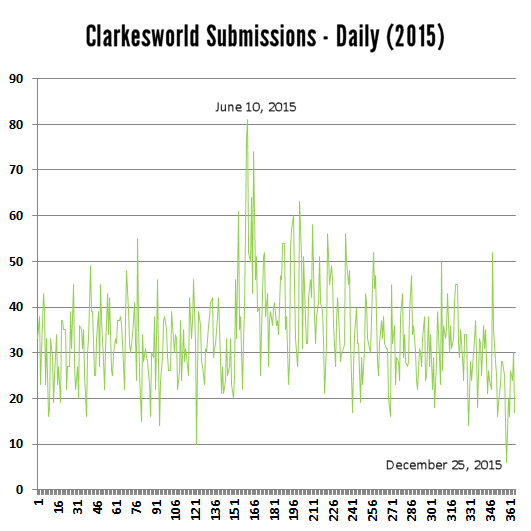
The spike in June corresponds with the increase in our upper word count limit to 16,000. A number of writing-for-pay websites capitalized on the announcement and sent hundreds of people our way.
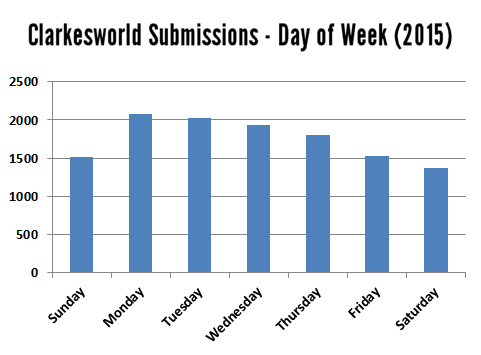
We get fewer submissions on the weekend.
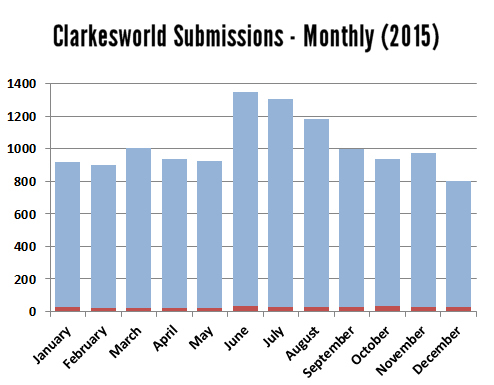
This chart shows the submissions by month in blue and the “near miss” letters by month in red. In 2015, 2.53% of all submissions received our top-tier rejection letter. The monthly average for submissions was just over 1000 and the first two months of 2016 have trended higher.
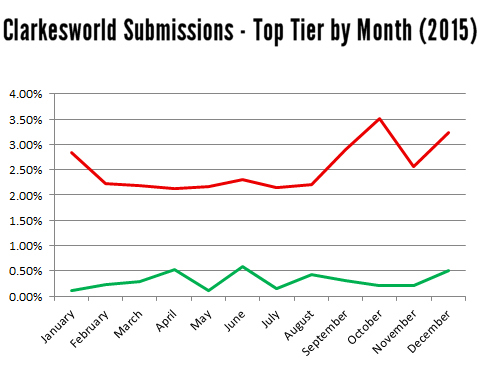
The red line represents top-tier rejections and the green line represent acceptances. The acceptance rate for 2015 was 0.03%.
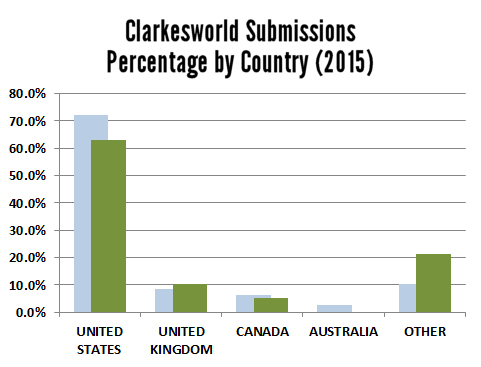
In 2015, we received submissions from 109 different countries. In the above chart, the blue bar represents the percentage of total submissions for that country. The green bar indicates the percentage of all acceptances. (Reminder: The Chinese translations are handled by a separate process and not included in these numbers.)
Note: If you feel inclined to proclaim that this data indicates that I have a bias towards international submissions, perhaps you should read this editorial. That said, it pleases me that Clarkesworld has a more global representation of science fiction. There’s a lot of great work written beyond our shores.

This chart breaks out “other” in the prior chart and only includes countries from which we received 10 or more stories. Interestingly, China’s numbers have fallen despite our special translation project. I’m wonder if Chinese authors think that’s their only way in now. (It isn’t.)
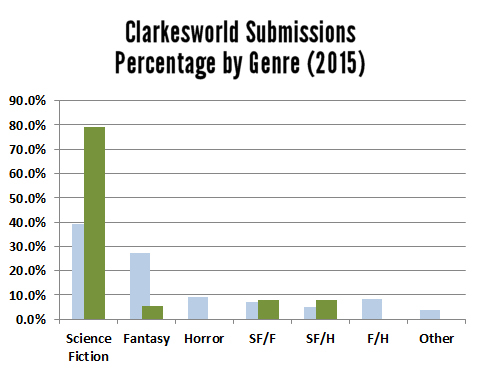
In this chart, blue bars represent the percentage of submissions and green indicates the percentage of accepted stories. 2015 was a very strong year for science fiction submissions. I was hesitant to post this graph for fear of discouraging writers in other genres. We want those submissions too.
This last bit of data doesn’t require a chart. The average word count for our 2015 story submissions was 4495. That’s fairly consistent across genres with the exceptions of horror (shorter) and SF/F (longer). Acceptances, however, averaged 5650 words. I expect both of these values to climb slightly in 2016. (More to do with the higher word count limit than a specific preference.)
Added 4:50PM BONUS CHART!
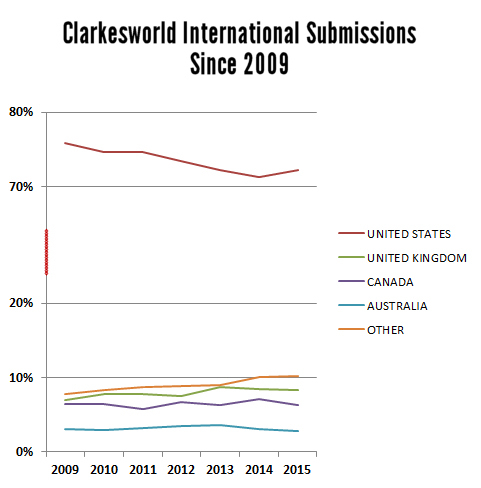
March 4, 2016
Clarkesworld Magazine – March 2016

Our March 2016 issue (#114) contains:
Original stories by Jack Skillingstead (“Salvage Opportunity”), A.C. Wise (“Seven Cups of Coffee”), Leena Likitalo (“The Governess with a Mechanical Womb”), Kij Johnson (“Coyote Invents the Land of the Dead”), and Gu Shi (“Chimera”).
Reprints by Cecelia Holland (“The King of Norway”) and Karl Bunker (“Gray Wings”).
Non-fiction by Mark Cole (The Age of the Excessive Machine: Psychedelic SF, On-Screen and Off), an interview with Charlie Jane Anders, an Another Word column by Genevieve Valentine, and an editorial by Neil Clarke.
PURCHASE THIS ISSUE AT:
Amazon Kindle
B&N EPUB
Clarkesworld Android App – Google Play
Clarkesworld iPad/iPhone App – iTunes
Kobo EPUB
Weightless EPUB/MOBI
Wyrm EPUB/MOBI
Forever Magazine – March 2016
February 25, 2016
The Berlin Quarterly
I’ve been sitting on this news for a long time, but the publisher has finally broken the news…
I am the guest fiction editor for a special science and science fiction issue of The Berlin Quarterly, a European print review of long form journalism, literature, and the Arts.

Despite being headquartered in Berlin, each issue is published in English and copies are available in New York, London, and a number of other locations inside and outside of Germany.
Their budget permitted me to select four reprints, so in this issue you’ll find:
“Slipping” by Lauren Beukes
“Tying Knots” by Ken Liu
“A Brief Investigation of the Process of Decay” by Genevieve Valentine
“The Best We Can” by Carrie Vaughn
Can’t wait to get my hands on an issue!
February 18, 2016
My Boskone Schedule
I’m attending Boskone this weekend and here’s my schedule:
Small Presses & Magazines: Welcoming the Unexpected
Friday 17:00 – 17:50, Griffin (Westin)
Authors in the slipstream, weird, magical realism, or speculative literature categories can have a hard time finding the right home for their work. With stories that aren’t always a good fit for the larger genre markets, it’s still important to find quality publishers. Such homes exist in both the literary and SF/F/H publishing communities. This panel will take a “deep dive” into the world of small presses and magazines, presenting fantastic venues and discussing hard-learned lessons such as publishers that promised more than they could deliver. Whether you’re looking for good work a little off the beaten path or trying to find potential new markets for your writing, this panel is for you.
Julia Rios (M), Kate Baker, Neil Clarke Shahid Mahmud
Kaffeeklatsch 2: Neil Clarke
Friday 18:00 – 18:50, Harbor I-Kaffeeklatsch 2 (Westin)
How Story Works
Saturday 11:00 – 11:50, Marina 2 (Westin)
Pixar filmmaker Andrew Stanton claims in his TedX talk that “the fundamental promise of a story is that this tale will lead somewhere that is worth your time.” Is there more to story than a well-told promise? What is story? How is it constructed? What compels us to consume story in all its forms?
Darrell Schweitzer (M), Neil Clarke, Chris Irvin, Paul G. Tremblay, Gary K. Wolf
Autographing: Neil Clarke, E.C. Myers, Charles Stross, E. Lily Yu
Saturday 15:00 – 15:50, Galleria-Autographing (Westin)
The Economics of Magazine Publishing
Sunday 12:00 – 12:50, Marina 4 (Westin)
Many publish for love, others for prestige. Some even manage to turn a profit. From circulation to ad revenue, staff turnover, and content acquisition, what factors are critical to the sustainability of magazines and e-zines? What’s the cold hard truth on the bottom line of your balance sheet?
Julia Rios (M), Neil Clarke, Shahid Mahmud, Steve Davidson
Inside the Editing Process
Sunday 13:00 – 13:50, Harbor III (Westin)
How does the editorial process work? Editors must deal with a variety of writers, each with his or her own style, preferences, and agenda — while keeping an eye on management, markets, and much more. How does the revision process proceed? What do editors really do?
John R. Douglas (M), Neil Clarke, Steve Davidson, Stacey Friedberg, Patrick Nielsen Hayden
February 5, 2016
Galactic Empires Guidelines
Nothing quite captures the imagination of a science fiction reader or author more than the galactic empire: vast, ancient, and full of secrets! From tales of sweeping space opera battles to stories of palace intrigue, from renegade freedom fighters to dangerous princes and princesses, and more, these galaxy-spanning stories both define—and challenge—the field.
REPRINT ANTHOLOGY – Print and Ebook
Publisher: Night Shade Books
Editor: Neil Clarke
Rate: One cent per word advance against pro-rata share of royalties
Length: 2000 – 20000 words
Genre: Science Fiction
Language: English language (translations welcome)
Format: .doc or .rtf
DEADLINE FOR SUBMISSIONS: MARCH 19, 2016
Submit stories at: neilclarke.sendsubmission.com
Recommend stories by commenting on this post or as an email to neil@clarkesworldmagazine.com.
February Issue of Clarkesworld
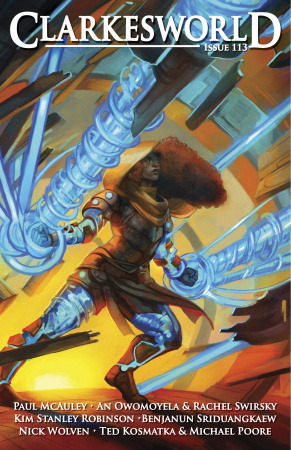
FICTION (stories will be podcast throughout the month)
“The Fixer” by Paul McAuley
“That Which Stands Tends Toward Free Fall” by Benjanun Sriduangkaew
“In the Mist of Life” by Nick Wolven
“Between Dragons and Their Wrath” by An Owomoyela and Rachel Swirsky
“Blood Dauber” by Ted Kosmatka and Michael Poore (reprint)
“Mercurial” by Kim Stanley Robinson (reprint)
NON-FICTION
Six Quirks of the Human Genome by Dan Koboldt
Sapient Animals and Memory Particles: A Conversation with Lawrence M. Schoen by Chris Urie
Another Word: Very Close Now by Fran Wilde
Editor’s Desk: The Roundup by Neil Clarke
ART
“Power Surge” by Julie Dillon
This issue is now available via:
Amazon Kindle
B&N EPUB
Clarkesworld Android App – Google Play
Clarkesworld iPad/iPhone App – iTunes
Kobo EPUB
Weightless EPUB/MOBI
Wyrm EPUB/MOBI
Online




